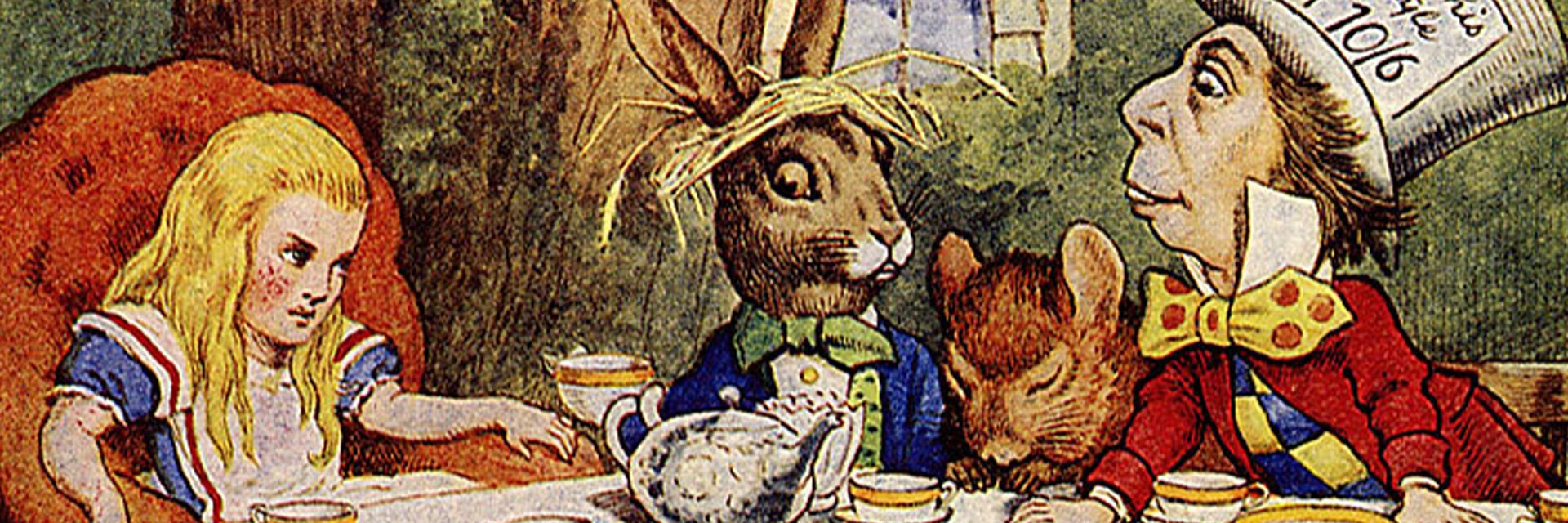Alice’s Adventures in Wonderland is universally admired for its ability to speak to readers both young and adult through its fanciful language and expansive narrative tableaux of colorful, eccentric characters. Would you be surprised to learn that its author, Charles Dodgson, aka Lewis Carroll, undergirded Alice with a hidden world? Several scholars have “cracked the code” to reveal that Dodgson, an Oxford math professor, augmented several of his best-known scenes with theoretical math. Let’s crack open some of these “Easter eggs” the author planted for our astonishment and delight.
◊
"Alice had begun to think that very few things indeed were really impossible."
We all think we know the story of Alice in Wonderland. But what if we’re missing something really interesting about this beloved – and often bizarre – story?
For example, soon after tumbling down the rabbit hole, Alice begins trying to reconcile what she was experiencing with what she thought she knew:
“[O]h dear, how puzzling it all is! I’ll try if I know all the things I used to know. Let me see: four times five is twelve, and four times six is thirteen, and four times seven is—oh dear! I shall never get to twenty at that rate!”
What fun to laugh along with Alice’s obvious confusion – but wait. What if she’s correct and just doesn’t know it? To some specialized readers, her mathematics, strange though it seems, is accurate. But not if you limit yourself to the traditional “base-10” form of math – the one we use every day.
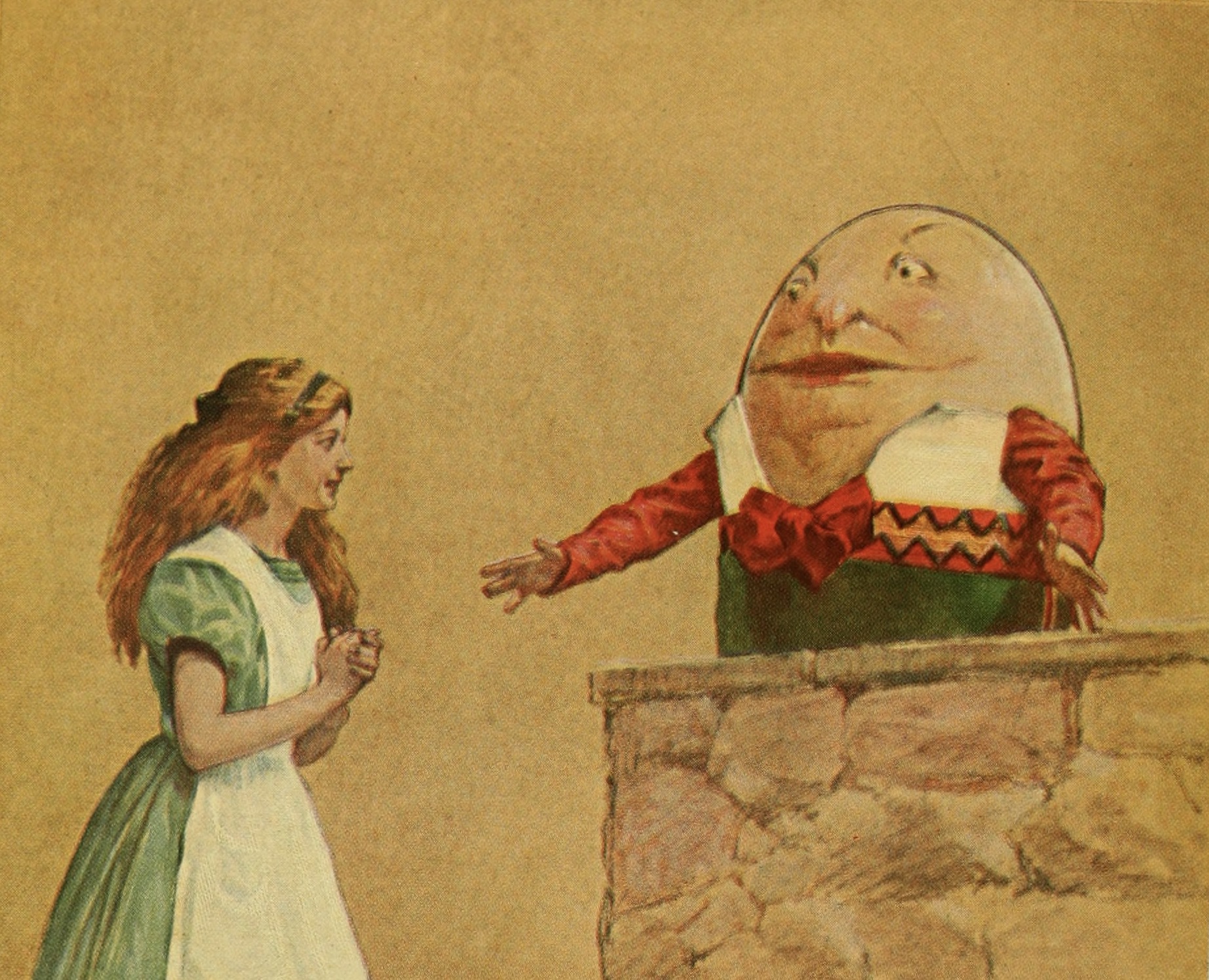
Source: Wikimedia Commons
What Alice’s author, Lewis Carroll, was doing was having a little fun at the expense of “abstract” mathematics, the leading edge of math in his day. If you switch out of base-10 calculations and into, say, base-18, where digits switch at 18, then four times five is 12; in base 19, four times six is 13; and so on, never getting to 20, just as Alice inadvertently foresaw.
To general readers of Alice’s Adventures in Wonderland, this section seems like nonsense. But it may actually be a skewering of the math trends of Carroll’s day, presented for his own and his peers’ amusement.
Lewis Carroll’s Invention of Alice, with Help from Charles Dodgson
"Alice thought the whole thing very absurd."
Carroll’s real name was Charles Dodgson, a professor of mathematics at Oxford University. He did his best to keep these mathematical incursions into the narrative hidden, secreted away, only to be discovered by practitioners of advanced math.
Alice encounters numerous “impossible” situations (and handles them with remarkable grace, all things considered). As she attempts to fit in with her increasingly “curiouser” surroundings, we are likely to feel amused, if not slightly discomfited, by the depths of nonsense, absurdity, and downright surrealism in which she finds herself immersed.
Dodgson/Carroll wrote Alice for young people’s entertainment. He reportedly had children “focus-test” an early version to ensure it was child-friendly. And it certainly has a large contingent of fans who would put it in the pantheon of children’s fantasy/nonsense literature, perhaps the first and best example.
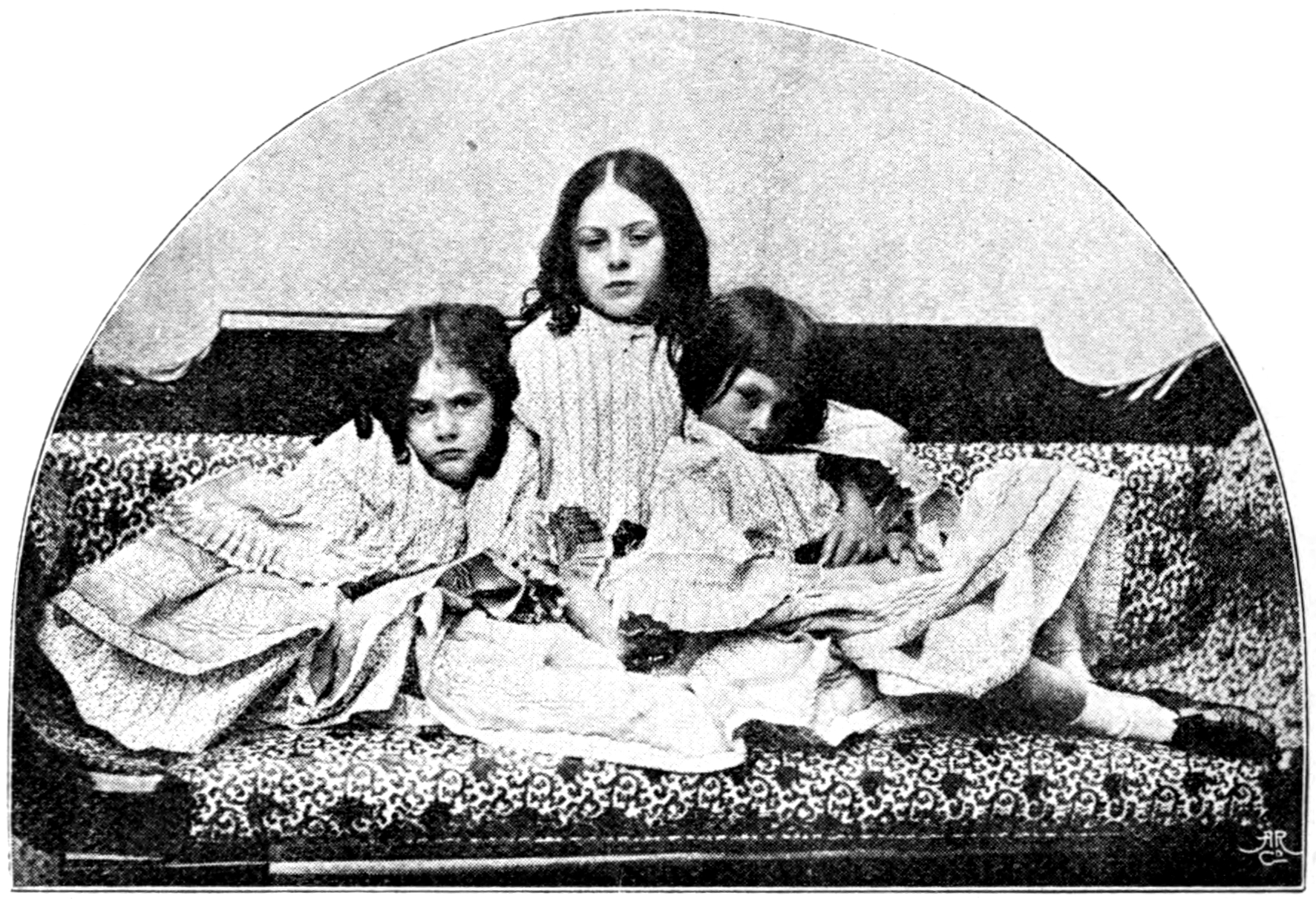
The Lidell sisters: Lorina, Alice, and Edith (Source: Stuart Dodgson Collingwood, 1898. via Wikisource)
From early on, however, Carroll’s classic tale has appeared to perceptive readers as something more. The introduction of twisted logic – and even the frequent absence of logic – opens the book to deeper readings. Freudian interpretations of Alice made much of the descent from the “conscious” level of the midsummer-day setting to the deeper, more remote subterranean recesses of the unconscious. And the book’s playful, sometimes nonsensical tone valorized it to some 20th century readers as a precursor to the art and literary movements of Dada and Surrealism.
But to advanced readers, Alice’s Adventures in Wonderland may very well be a work in the unique genre of mathematical satire!
Lewis Carroll’s Mathematical Rationale
“No wise fish would go anywhere without a porpoise.”
While Charles Dodson’s alter ego, Lewis Carroll, wrote beloved tales for children’s entertainment, Dodgson himself had a rather more mundane life. As an Oxford professor, he was close with the dean of the college where he taught, who was the father of the real-life Alice who inspired the tale that bore her name.
Dodgson was known in mathematics circles as an educator who revered the Classical beginnings of his field of study, and he saw the ancient Greek Euclid as the paragon of heuristic elegance and eloquence. The great mathematician, who lived in Alexandria, Egypt, in the 4th century BCE, gave his name to Euclidean geometry. His Elements was a model of logic and mathematical rigor, as well as clarity.
Euclid is known for what are called “mathematical proofs,” step-by-step accumulations of agreed-upon facts that combine to demonstrate, or “prove,” a mathematical theorem. His proofs were often completed with a flourish, the rhetorical statement quod erat faciendum (literally, “which had to be done”), or QEF, a close cousin to the better known argument-ender QED (“which had to be shown”).
Dodgson taught Euclid’s “logical” geometry to Oxford undergrads in the mid-19th century, an era that was (among other things) a hot cauldron of burning issues for mathematicians like Dodgson. It was during this time that Euclid’s point of reference for math was being challenged on numerous fronts.
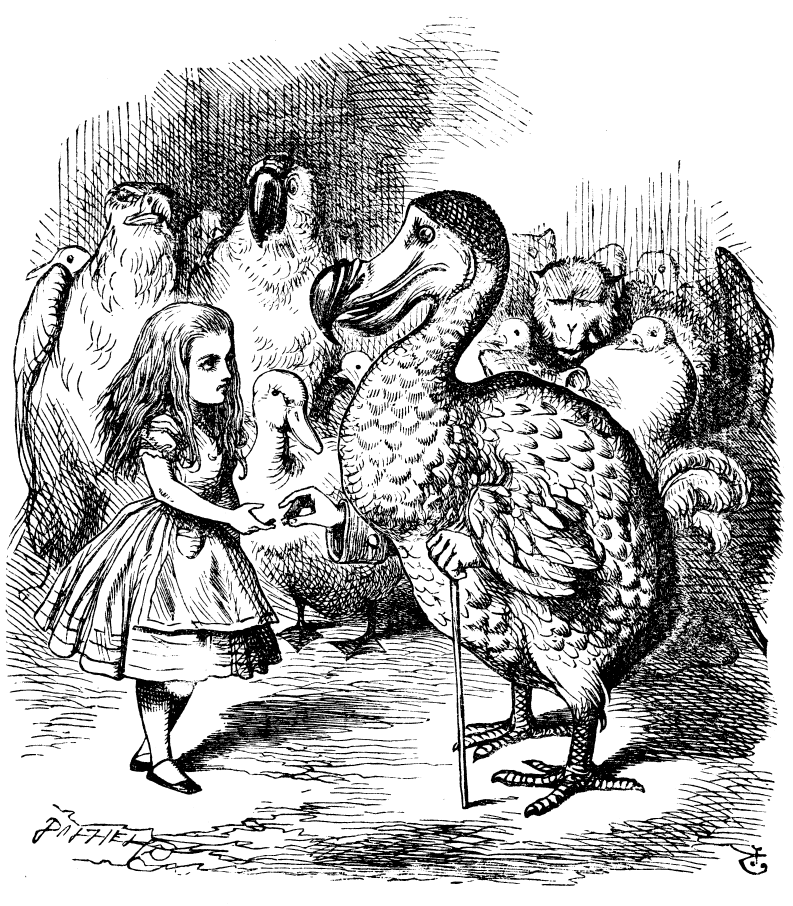
Alice in Wonderland illustration (Source: John Tenniel, 1865, via Wikimedia Commons)
Mathematical thinking of Dodgson’s time was rapidly evolving with the introduction of “abstract” math concepts, including such ideas as “imaginary” integers (for example, the square root of a negative number) and non-Euclidean geometry, which was pointedly not based on a correspondence with nature.
Frankly, Dodgson the educator and traditionalist was horrified by abstract math. He railed against its “unteachability” to undergrads, and found the development of non-Euclidean anything to be anathema to his philosophy of mathematical education.
Alice Mocks New-Fangled Forms of Logic
"The queen was in a furious passion . . . shouting 'Off with his head!' "
Without calling attention to itself, Carroll’s prose in Alice could easily be described as being full of “Easter eggs,” those semi-hidden callouts to those whose awareness of the subject matter exceeds those of casual readers. (The rune riddles from Lord of the Rings are another example of a literary Easter egg.)
Dodgson’s sense of intellectual outrage lent itself to wicked satire all through Alice’s Adventures in Wonderland. Any chance he had to skewer the “illogic” of abstract mathematics, he took. And it turned out that this reversal of traditional logic, when applied to a narrative, created some wildly illogical – and wildly entertaining – scenes throughout the novel.
Carroll, Dodson’s literary persona, presents a “critique of illogic” in the Alice stories that produced a rich world of symbolic takes on narrative realism that generations of writers found liberating. It can even be said that his work was the progenitor of a genre of fiction where rules of logic are altered or suspended, from The Wizard of Oz to The Hobbit and beyond.
When viewed this way, many well-known scenes from Alice take on a special significance, including the Mad Hatter’s Tea Party, the Duchess and her baby, and the mysterious and quite absurd Cheshire Cat.
The Cheshire Cat Purrs at the Borders of Logic
“We’re all mad here. I’m mad. You’re mad.”
Alice’s series of encounters with the Cheshire Cat is a prime example of Dodgson’s hidden interventions. The Cheshire Cat appears to Alice numerous times in the course of the novel, and its commentary on the course of the plot is at once knowing and completely bonkers. First sighted outside the Duchess’s window, the Cat gives its assessment of the situation quite frankly. Alice asks:
“Would you tell me, please, which way I ought to go from here?”
“That depends a good deal on where you want to get to,” said the Cat.
“I don’t much care where—” said Alice.
“Then it doesn’t matter which way you go,” said the Cat.
The Cat seems unbound by the rigors of illogic in the absurd kingdom into which Alice has fallen, and speaks so plainly that even its internal logic appears absurd. We can see, then, that the Cheshire Cat takes the point of view of pure, traditional logic, which in this environment seems just as mad as any other point of view.
.jpg)
Cheshire Cat appearing, from Alice in Wonderland, 1865 (Source: John Tenniel, illustrator, via Wikimedia)
It would seem that the only logical response to the lunacy is to declare oneself a lunatic as well. When Alice demands that the Cat explain itself, it offers this nugget: “[A] dog growls when it’s angry, and wags its tail when it’s pleased. Now I growl when I’m pleased, and wag my tail when I’m angry. Therefore I’m mad.”
While the Cat may represent the point of view of its author, other characters in Wonderland display quirks of another stripe indeed. Let’s take the Duchess, whom we meet in her kitchen with her suckling baby while the cook is preparing a soup with copious amounts of pepper.
The Duchess (it’s OK if you don’t remember her, as this scene was left out of the Disney version) is feeding her baby, and when the baby sneezes while being held by Alice it promptly turns into a pig. All other things being equal, the pig does still bear somewhat of a resemblance to the baby. But when Alice lets it go outside the Duchess’s residence, it ambles off contentedly into the forest. Ergo, the baby is an equivalent of a pig, with porcine tendencies.
This is all meant as a broadside against the then-new, abstract mathematics of Jean-Victor Poncelet, who held that geometric figures retain characteristics of themselves even when undergoing continuous transformation. While this idea may not seem exceptional or logic-defying to contemporary minds, to Dodgson it may as well have been infernal in origin. Of course, Poncelet was describing geometric rather than biological figures, but it made no difference to Carroll, whose reductio ad absurdum here made the case for a piglet to be a piglet, and the baby a baby.
The Mad Hatter’s Tea Party and the Use (and Abuse) of Time
“[T]he stupidest tea-party I ever was at.”
Justly famous, the Mad Tea Party brings the use of nonsense in Carroll’s tale to new heights. There are many highlights, such as the koan-like brilliance of the riddle, “How is a raven like a writing desk”; the constant movement of the three invited guests around the table; and the keen wit of the language.
For math scholars, there’s even more. This Tea Party is an extended discourse on the work of Irish mathematician William Rowan Hamilton, who discovered an abstract concept called quaternions, a complex number configuration that relied on four terms. However, for years Hamilton worked with three terms and found that they could only be made to establish a rotation of the terms on a flat plane – like a table with room for only three.
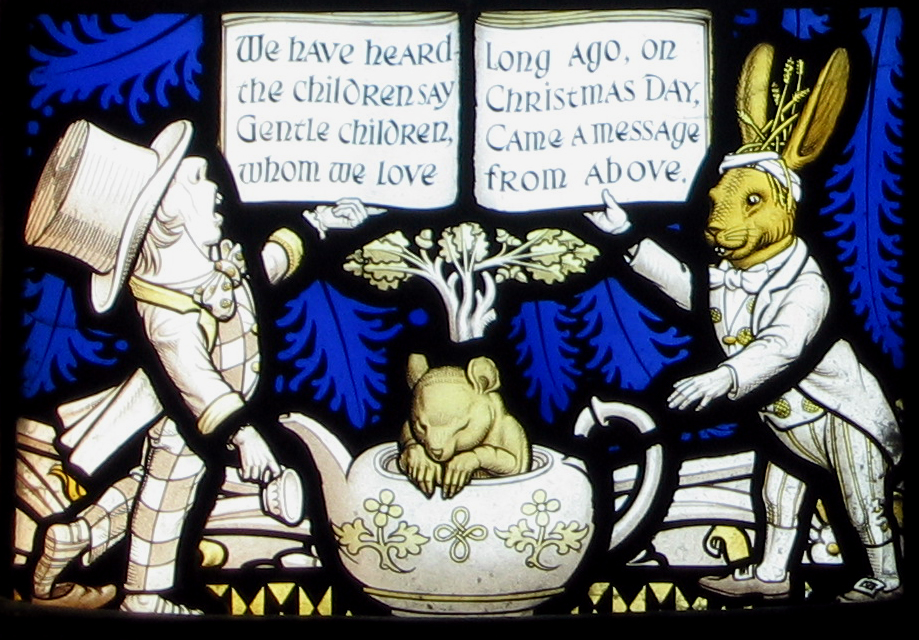
Source: Peter I. Vardy, Public Domain, via Wikimedia
He later added a term to his calculations that allowed the rotation to take place in three-dimensional space, and the term he added was – note this – Time. This makes the March Hare’s repeated references to a lack of time, or a loss of time, fall right into place in Carroll’s takedown of Hamilton’s “absurd” conjecturing on quaternions.
Dodgson’s attempted rebellion against new forms of mathematics is examined in the context of the history of math in the playful MagellanTV documentary series Magic Numbers.
A Traditionalist’s Take on a Complex New Reality
“I’ve had such a curious dream!”
In a sense, Carroll was tilting at windmills à la Don Quixote; it was quixotic at best to try to defeat advances in math, and particularly in abstract mathematics, with satiric symbols and metaphors hidden within a tale ostensibly for children.
But how crafty, then, to construct a web of veiled references to people and issues he knew all too well. They certainly knew they were receiving a reductive ribbing, to the point of absurdity, and that must have given satisfaction to Dodgson. Mathematics gave Alice a covert, second level of meaning, and made it the kind of puzzle that could continue providing surprises to its readers, even a century-and-a-half later.
Ω
Kevin Martin is Senior Writer for MagellanTV. He writes on a wide variety of topics, including outer space, the fine arts, and modern history. He has had a long career as a journalist and communications specialist with both nonprofit and for-profit organizations. He resides in Glendale, California.
Title Image Source: John Tenniel, illustration for Lewis Carroll's Alice in Wonderland (1865)
